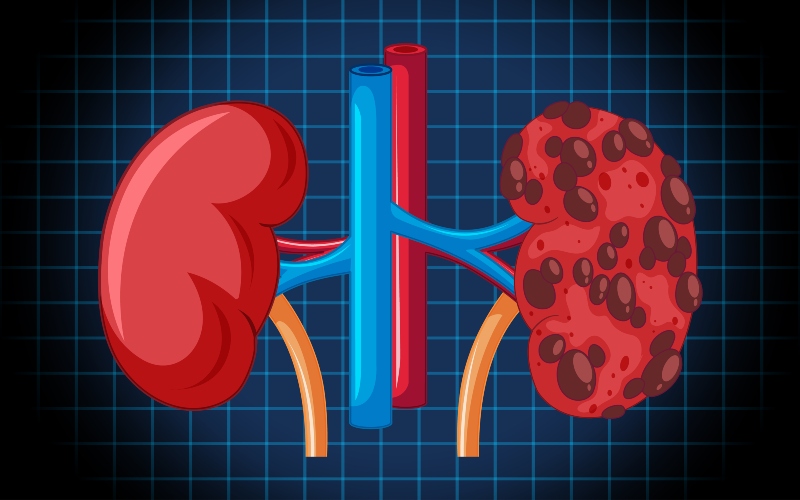Chronic kidney disease surpasses tuberculosis and colorectal cancer in mortality rankings

In 2023, CKD caused an estimated 1.48 million deaths globally, making its first appearance in the top ten causes of mortality. It now ranks ninth, surpassing tuberculosis and colorectal cancer, and just ahead of liver disease.
Chronic kidney disease (CKD) has emerged as a major global health concern, now ranking among the top ten causes of death worldwide.
A recent report in The Lancet estimates that over 800 million adults, more than one in ten globally, are living with CKD.
More To Read
- Study reveals why colorectal cancer resists immunotherapy
- Kidney transplant breakthrough could save thousands waiting for compatible donors
- Experts reject kidney harvesting claims, point to system failures
- MPs hear harrowing testimonies of kidney trafficking in Uasin Gishu
- MPs launch probe into kidney transplants on foreign nationals in Eldoret hospitals
- KNH clarifies failed kidney transplant amid patient’s police report
CKD is a long-term condition where the kidneys gradually lose their ability to filter waste and excess fluid from the blood. It is defined by kidney damage or a glomerular filtration rate (GFR) below 60 mL/min/1.73 m² for three months or more. If untreated, it can progress to kidney failure, requiring dialysis or a transplant.
Early CKD often presents no symptoms. As it advances, individuals may experience fatigue, swelling, changes in urination, shortness of breath, persistent itching, nausea, muscle cramps, high blood pressure, and difficulty concentrating.
Because symptoms are subtle, many cases are diagnosed late, highlighting the importance of early screening, especially for high-risk groups such as those with diabetes, hypertension, or a family history of kidney disease.
In 2023, CKD caused an estimated 1.48 million deaths globally, making its first appearance in the top ten causes of mortality. It now ranks ninth, surpassing tuberculosis and colorectal cancer, and just ahead of liver disease. Only stroke, ischemic heart disease, COPD, dementia, lung cancer, diabetes, lower respiratory infections, and hypertensive heart disease caused more deaths.
The Lancet study identified high blood sugar, mainly from type 2 diabetes, as a leading contributor, along with high blood pressure and elevated body mass index (BMI). Poor dietary habits, such as low fruit intake and high sodium consumption, were also cited as modifiable risk factors.
The global age-standardised mortality rate for CKD rose from 24.9 per 100,000 in 1990 to 26.5 in 2023. This contrasts with many other major diseases whose mortality rates have stabilised or declined, suggesting that current interventions for CKD are inadequate.
Globally, CKD affects about 14 per cent of adults aged 20 and above. The disease is particularly prevalent in North Africa, the Middle East, South Asia, sub-Saharan Africa, and Latin America. China and India alone account for approximately 152 million and 138 million cases, respectively.
Diagnosis, treatment options
Beyond direct mortality, CKD significantly contributes to cardiovascular disease, being linked to nearly 11.5 per cent of cardiovascular deaths worldwide.
CKD often develops silently. Many patients remain asymptomatic until significant kidney damage has occurred. As kidney function declines, waste and fluid accumulate, causing fatigue, swelling, itching, and breathlessness.
Diagnosis frequently occurs at advanced stages, when treatment options are limited. Without intervention, kidney failure is fatal. Advanced CKD requires dialysis or transplantation, underscoring the need for early detection and preventive care.
The Lancet study analysed data from 2,230 research papers and national health datasets across 133 countries, focusing on adults aged 20 and older from 1990 to 2023.
Using advanced statistical models, including the Cause of Death Ensemble model and Bayesian meta-regression, researchers estimated CKD-related deaths, prevalence, incidence, and disability-adjusted life years (DALYs). This comprehensive analysis offers valuable insights for policymakers and health practitioners.
In Kenya, CKD is a growing public health issue, contributing to premature death and long-term disability. The Kenya Renal Association estimates that around 4 million Kenyans live with some form of kidney disease, a number projected to rise to 4.8 million by 2030.
A 2022 study placed CKD prevalence in Kenya at about 4 per cent, slightly below the sub-Saharan African average. Despite this, the disease places a heavy burden on the healthcare system due to the high cost of long-term management, dialysis, and transplantation.
CKD risk
Several factors increase CKD risk. Age is a key determinant, with those over 60 particularly vulnerable. Hypertension and diabetes are the leading causes of kidney disease and the need for replacement therapy.
HIV infection also contributes to CKD risk, reflecting the dual burden of infectious and non-communicable diseases. Lifestyle factors such as smoking, alcohol use, physical inactivity, and certain herbal medicines are also linked to higher CKD prevalence. These risks highlight the need for integrated interventions that combine lifestyle changes with chronic disease management.
CKD not only affects individual health but also strains healthcare systems. In Kenya and other low- and middle-income countries, limited infrastructure for dialysis, transplantation, and long-term care exacerbates disparities in outcomes. Many patients are diagnosed late, reducing treatment effectiveness and increasing mortality.
The Lancet report emphasises that CKD is both a cause and consequence of other major health conditions. It often coexists with cardiovascular disease, diabetes, and hypertension, creating a cycle in which each condition worsens the others. Addressing CKD requires a holistic approach that includes prevention, early diagnosis, and management of comorbidities.
Health systems must implement robust screening programs targeting high-risk populations, older adults, people with diabetes or hypertension, and those with HIV. Public health strategies should also promote lifestyle changes, including healthy diets, regular exercise, and avoiding tobacco and excessive alcohol.
In Kenya, CKD remains a rising concern. Challenges include limited awareness, inadequate screening, and constrained healthcare resources. However, growing recognition of CKD as a public health priority presents an opportunity for targeted action.
Early detection, risk factor management, and improved access to treatment could significantly reduce CKD-related illness and death. Policymakers are urged to integrate CKD into national health strategies alongside broader efforts to combat non-communicable diseases like diabetes, hypertension, and obesity.
Top Stories Today












































